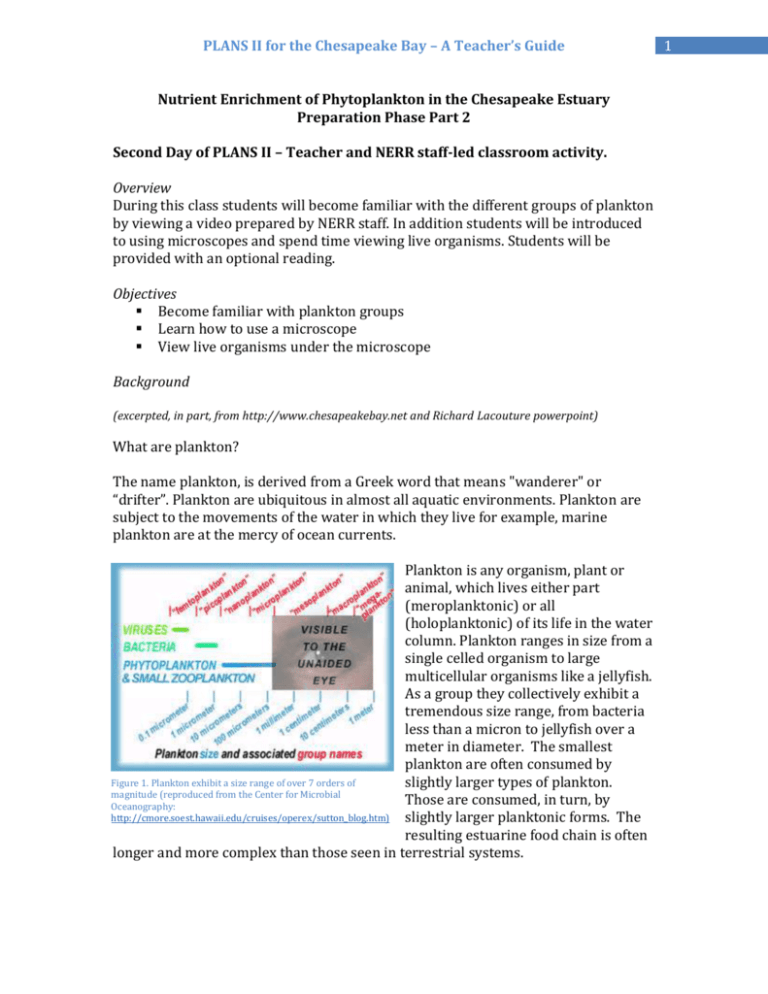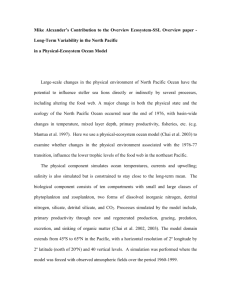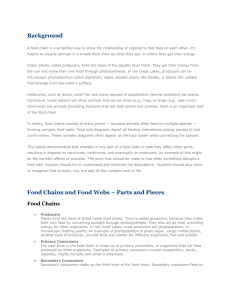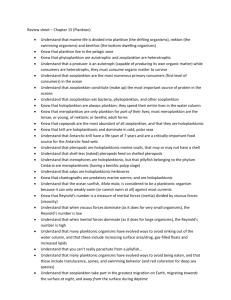Viewing Plankton Teacher Guide (Preparation Part 2)
advertisement

PLANS II for the Chesapeake Bay – A Teacher’s Guide Nutrient Enrichment of Phytoplankton in the Chesapeake Estuary Preparation Phase Part 2 Second Day of PLANS II – Teacher and NERR staff-led classroom activity. Overview During this class students will become familiar with the different groups of plankton by viewing a video prepared by NERR staff. In addition students will be introduced to using microscopes and spend time viewing live organisms. Students will be provided with an optional reading. Objectives Become familiar with plankton groups Learn how to use a microscope View live organisms under the microscope Background (excerpted, in part, from http://www.chesapeakebay.net and Richard Lacouture powerpoint) What are plankton? The name plankton, is derived from a Greek word that means "wanderer" or “drifter”. Plankton are ubiquitous in almost all aquatic environments. Plankton are subject to the movements of the water in which they live for example, marine plankton are at the mercy of ocean currents. Plankton is any organism, plant or animal, which lives either part (meroplanktonic) or all (holoplanktonic) of its life in the water column. Plankton ranges in size from a single celled organism to large multicellular organisms like a jellyfish. As a group they collectively exhibit a tremendous size range, from bacteria less than a micron to jellyfish over a meter in diameter. The smallest plankton are often consumed by Figure 1. Plankton exhibit a size range of over 7 orders of slightly larger types of plankton. magnitude (reproduced from the Center for Microbial Those are consumed, in turn, by Oceanography: http://cmore.soest.hawaii.edu/cruises/operex/sutton_blog.htm) slightly larger planktonic forms. The resulting estuarine food chain is often longer and more complex than those seen in terrestrial systems. 1 PLANS II for the Chesapeake Bay – A Teacher’s Guide What types of plankton live in the Chesapeake Bay? Plankton can be divided into three major classes: phytoplankton; zooplankton; and bacteria and viruses. Phytoplankton (Phyto – meaning “plant”) Major groups of phytoplankton in the Chesapeake Bay include: Diatoms (Bacillariophyta) Golden brown algae (Chrysophyta) Green algae (Clorophyta) Blue-green algae (Cyanophyta) Dinoflagellates (Pyrrophycophyta) Cryptomonads (Cryptophyta) Microflagellates (Prasinophyta, Euglenophycota, Protozoa) Pytoplankton are mostly microscopic, single-celled plants that live in aquatic habitats. As we have learned previously, they require sunlight and nutrients to produce food via photosynthesis. Phytoplankton are vital organisms in the environment because, they serve as the base of the food chain and produce vast quantities of oxygen. Zooplankton (Zoo – meaning “animal”) Zooplankton are animals that range in size from single-celled protozoa to tiny fish larvae to larger jellyfish. One gallon of water can contain more than a half-million zooplankton. The zooplankton community is composed of both primary consumers (which eat phytoplankton) and secondary consumers (which feed on other zooplankton). Nearly all fish depend on zooplankton for food during their larval phases, and some fish continue to eat zooplankton their entire lives. One herring may consume thousands of copepods — the most abundant type of zooplankton found in the Bay. The smallest zooplankton are able to recycle nutrients found in the water column. Because of this, they are often closely tied to nutrient pollution measurements. Larger zooplankton are important food for forage fish and fish larvae. They also link the primary producers (phytoplankton) with larger or higher trophic level animals. Zooplankton also feed on bacteria and particulate plant matter. Tiny larvae of fish and invertebrates, which feed on copepods, are also considered zooplankton. Although this planktonic stage is only temporary 2 PLANS II for the Chesapeake Bay – A Teacher’s Guide (meroplanktonic), larvae are a significant part of the zooplankton community because they are a food source for larger animals. Zooplankton are distributed according to salinity and the availability of phytoplankton, their main food source. Like phytoplankton, zooplankton are excellent indicators of environmental conditions within the Chesapeake Bay because they are sensitive to changes in its health. Scientists can get a good picture of current Bay conditions by looking at the amount and diversity of different species of zooplankton. Bacteria Bacteria play an important function in the Chesapeake Bay: Bacteria are the Bay's decomposers, breaking down dead matter. Through this process, nutrients in dead plant and animal matter again become available for growing plants. Bacteria are food for zooplankton and other filter-feeding organisms in the Bay. Bacteria can be residents of the Bay or be introduced through various pathways, including human sewage and polluted runoff from the land. Why are plankton communities so diverse? The water column habitat of plankton appears quite uniform. In other words, from the standpoint of an ecological niche, the water column seems to have few attributes that would contribute to a diversity of niches. However, there is a large diversity of plankton co-existing in that habitat. Most observations indicate that there is high plankton diversity, even in single groups such as phytoplankton. This runs counter to the “Competitive Exclusion Hypothesis” - a famous cornerstone of ecology that states that over the long-term only one species can occupy a single niche, while all other species are excluded as a result of competition. This seeming contradiction was expressed formally by G. E. Hutchinson in 1961. He termed it “The Paradox of the Plankton”. Much research has occurred since then to try to explain this paradox. Here are some of the more recent findings that have shed light on why the Paradox may occur: Competitive exclusion takes place in environments that are uniform in time and space. Even though the water column may seem be a fairly uniform environment, a closer examination indicates that it is not. 3 PLANS II for the Chesapeake Bay – A Teacher’s Guide o Physical and chemical factors in water columns vary with depth and season of the year. Water mixing during storms can also bring about environmental changes in the water column over even shorter time scales. o However, water mixing is surprisingly non-uniform. Even after a mixing event, the water column may have isolated “pockets” that differ in chemical or physical attributes. o Light penetration – both quantity and quality (color) - always vary with depth, making the water column as a whole non-homogenous. Even in a homogenous environment multiple species of plankton can co-exist indefinitely IF they have differing abilities to compete for different resources. For example, phytoplankton species “A” may be a better competitor for nitrogen than species “B”. However, “B” could be a better competitor for phosphorus than “A”. This could set up a situation in which there are oscillations in the populations of both “A” and “B”, but they continue to coexist. Why Are Plankton Important? Plankton communities form the base of the Chesapeake Bay food web, acting as food for fish, shellfish and other upper trophic level organisms. All fish and shellfish depend on plankton for food during their larval phases, and some species continue to consume plankton their entire lives. Plankton are often used as indicators of environmental and aquatic health because of their short life span and high sensitivity to environmental change. Materials needed Access to a computer and projector to view plankton video online One compound microscope for each pair of students Sample of live plankton Microscope slides and coverslips Pipettes and bulbs Paper towels Preparation Make copies of the Check for Understanding page of this document for each student Make copies of the student worksheet: Observing a Natural Plankton Sample students will fill this worksheet in as they view the plankton sample Prepare the classroom computer and projector by loading the video to be viewed. The video can be found on the PLANS II website 4 PLANS II for the Chesapeake Bay – A Teacher’s Guide Ensure each pair of students has one compound microscope, slides and cover slips, pipettes, bulbs and paper towels Review Optional Student Reading: An Introduction to Plankton in the Chesapeake Bay Procedure 1. View the video on plankton and have a brief discussion about plankton diversity 2. Ask students to pair up and sit at microscope 3. NERR staff and the teacher will demonstrate the correct way to prepare a wet mount 4. Have students prepare their wet mount as follows (Figure 2): a. Place a small drop of the sample in the center of the slide b. While holding a cover slip upright, carefully place one edge of the cover slip next to the water. c. Slowly lower the upper edge of the cover slip onto the water. The objective is to minimize or eliminate air bubbles under the cover slip. You might find it helpful to use one toothpick to hold the lower edge in place, while using another to carefully lower the slip into place. Figure 2. Preparing a wetmount. (Image from: http://tes.geog.tamu.edu/kdk/) 5. Ask the students to stop here and watch the NERR staff demonstrate the correct way to view a slide under the microscope 6. Have the students place the slide on the microscope stage and begin examining the slide on the lowest magnification 7. As the students are examining their slide, ask them to complete the student worksheet: Observing a Natural Plankton Sample 8. Some students may find different groups of plankton, so ensure each student has had the chance to view all the groups in the plankton sample. It may help to keep a list on the classroom board as students find things 5 PLANS II for the Chesapeake Bay – A Teacher’s Guide Checking for Understanding 1. What am I? Group:_____________________________________________ Do I photosynthesize? Yes / No How do I get my nutrition?_______________________ What eats me? ____________________________________ Am I phytoplankton or zooplankton? (circle choice) 2. What are we? Group:_____________________________________________ Do I photosynthesize? Yes / No How do I get my nutrition?_______________________ What eats me? ____________________________________ Am I phytoplankton or zooplankton? (circle choice) 3. What am I? Group:_____________________________________________ Do I photosynthesize? Yes / No How do I get my nutrition?_______________________ What eats me? ____________________________________ Am I phytoplankton or zooplankton? (circle choice) 6 PLANS II for the Chesapeake Bay – A Teacher’s Guide Illustrations from www.biodidac.com Preparing for next class The next class period will be used for setting up their model nutrient enrichment bioassay and making initial observations. Due to the time constraints of the class period, there will not be time to discuss the concepts of experimental design. Therefore, you should prepare your students by introducing the topic to them. They should understand the terminology: blank, control and treatment – refer to the background material in the teacher’s guide for class period 3. Please ensure your light box is assembled. 7







